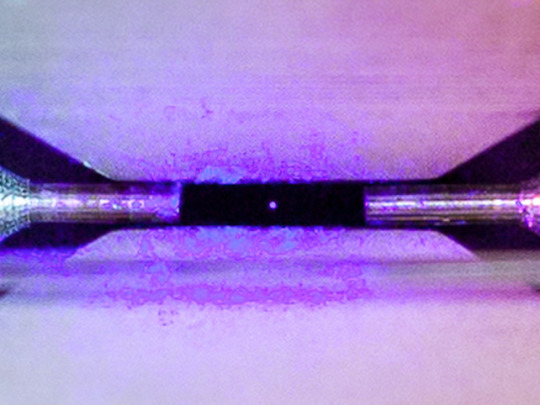Photo

This single isolated Strontium atom - that small little white dot in the middle of the middle black segment - is so big that it’s visible to the naked eye; or well, to a digital camera.
Here’s another look at it zoomed in:

For size comparison, the distance between the two metal bits to the right and left of the atom is ~2mm in width, or in more practical terms: approximately the width of an uncooked spaghetti noodle.
It takes an atom with 38 protons and 50 neutrons to show up as a dot like that (see image below). Mind-blowing!

This image never fails to reinvigorate my passion for my studies in chemistry and particle physics as seeing an atom with my own eyes, and knowing I have the ability to control something so miniscule, albeit when in bulk mostly, reminds me that this power I wield is not just some logical theory I have attributed to the before and after products of my work, but is undeniably true as I am looking with my own eyes.
It’s hard to explain but it’s as though there is a disconnect in my understanding between the logic of knowing that these must exist versus actually seeing that they do exist. Like, I can understand something with superb intuition in lecture that I just can’t seem to apply when it comes to the lab.
I suppose seeing truly is believing.
Also, just to add to the impossibility of this feat: to illuminate the atom, a blue-violet laser was shone onto it, allowing the light to be reflected off of it’s electrons back into the camera.
PS: Apparently the atom was not suspended by a magnetic field but rather by an electric field produced by nearby ions, and unfortunately I have yet to learn the difference between the two so I don’t know if that is redundant to point out, but I thought for educational purposes I might as well include that in case there is indeed a big difference between the two that I am not aware of.
#chemistry#chemist#atom#particle#science#physics#magnets#mindblown#awesome#universe#photo#chem#isolated#strontium#ion#laser#technology#digital#photography#education#naked#eye#quantum
0 notes
Text
We are all but a small subsect of this universe bound into a form capable of observing the rest of it. We may think our bodies and minds are our own, but the reality is much more interesting. If our minds are a product of our physical bodies, and our physicality is comprised of matter once belonging to an indiscriminate hodgepodge of many distant dead stars, then life itself must be parallel incarnations of this universe, miraculously bound into a form capable of observing itself, as our minds and our sense of individualism is a product of the borrowed space dust we call our bodies. Thus we are all the Universe Incarnate.
#philosophy#universe#meaning#life#unity#buddhism#enlightenment#physics#chemistry#particles#energy#matter#body#mind#soul
1 note
·
View note